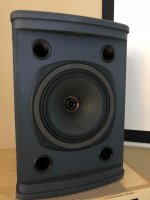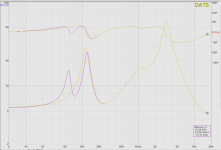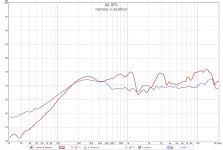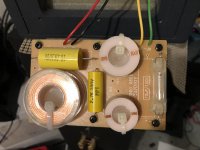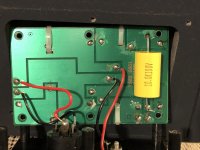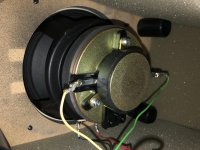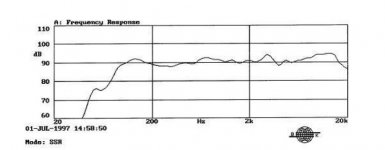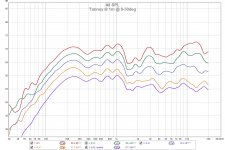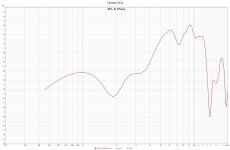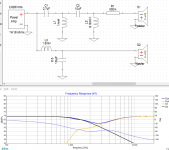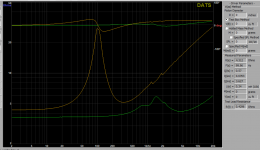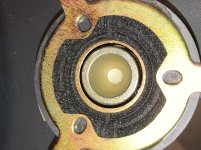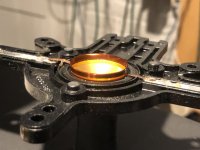Scored a pair of i8's and I'm kind of floored. I've been wanting to add a coaxial for a while now while aware of their flaws. But these are a blast.
When I demoed them at the seller's house, they didn't blow me away but they sounded better than his Heresy's. But I had low expectations and was just satisfied they were in working order.
I hastily set them up astride my desk and they were entertaining. Not an ideal setup but unfortunately where I listen the most. I then brought them upstairs and set them atop my Asathors and was kind of blown away. They really filled the room and kind of disappeared.
I did a quick measurement and compared to the Asathors. I'm guessing some of the perceived imaging increase might be a trick of the frequency response (measured on-axis).
At the moment, I have them back in the basement, each sitting on a 2x12 W-frame dipole sub. The combination seems to match the slam I get from the Asathor but completely different room. Now I just need to figure how to get the combination near my desk.
The cabinet, is 15mm MDF, lined with 1" foam, and devoid of bracing. So it seems there's a lot possibilities for experimentation.
When I demoed them at the seller's house, they didn't blow me away but they sounded better than his Heresy's. But I had low expectations and was just satisfied they were in working order.
I hastily set them up astride my desk and they were entertaining. Not an ideal setup but unfortunately where I listen the most. I then brought them upstairs and set them atop my Asathors and was kind of blown away. They really filled the room and kind of disappeared.
I did a quick measurement and compared to the Asathors. I'm guessing some of the perceived imaging increase might be a trick of the frequency response (measured on-axis).
At the moment, I have them back in the basement, each sitting on a 2x12 W-frame dipole sub. The combination seems to match the slam I get from the Asathor but completely different room. Now I just need to figure how to get the combination near my desk.
The cabinet, is 15mm MDF, lined with 1" foam, and devoid of bracing. So it seems there's a lot possibilities for experimentation.
Attachments
That's a very different FR to that given in the i8 manual. Almost wonder if the tweeter is the wrong phase as the dip is at x-over frequency.
The red graph looks out of phase to me as well.That's a very different FR to that given in the i8 manual. Almost wonder if the tweeter is the wrong phase as the dip is at x-over frequency.
Shallow slopes won't have as deep of a null.Out of phase, but not 180 degrees. So, time alignment issue most likely.
Could you given what we know about the drivers end up with a better response if you used a spread frequency XO to time align the woofer and tweeter
Last edited:
The response isn't a surprise. This is my Tannoy CD4. Fortunately the separate woofer/tweeter binding posts permit the simple hack of replacing the shorting jumper with a ~7 ohm resistor to flatten the response substantially. The distortion is well enough behaved for a mini bookshelf that I may try a hand at the crossover if I can ever figure out how to remove the driver glamour ring without damaging anything.
Other Tannoy models didn't fare much better at Audio Science Review. The 600s were once my office speakers and were never found listenable.
Tannoy System 600 Speaker Review | Audio Science Review (ASR) Forum
Tannoy Revolution XT 6 Speaker Review | Audio Science Review (ASR) Forum
A pair of 12" HDP Monitor Golds are still my favourites. BTW, agree that coaxials can do amazing imaging.
Other Tannoy models didn't fare much better at Audio Science Review. The 600s were once my office speakers and were never found listenable.
Tannoy System 600 Speaker Review | Audio Science Review (ASR) Forum
Tannoy Revolution XT 6 Speaker Review | Audio Science Review (ASR) Forum
A pair of 12" HDP Monitor Golds are still my favourites. BTW, agree that coaxials can do amazing imaging.
Attachments
Hi,
From my experience with system 800 ( and what can be seen in links provided of s600), this is related to the offset in depth between the direct radiator and hf. Iow Vacuphile is right.
It can be managed however. It'll depend of your plan:
_If you plan for passive filtering then as suggested by Martyh, spread of freq in filter can solve the issue. Asymetric filter as outcome most of the time.
Here is an example:
Phase Correction for Altec Ferrite Duplexes - Great Plains Audio
_If you can allow active filtering then it can be solved same way Tannoy did for the System800A: they used the native response of tweeter to implement hp filtering, then applied to allpass cells in serie to the direct radiator and an lp filter to correct for the wide notch @ xover freq. There is some eq applied too in both way.
It's done actively with a bunch of opamp and this drive a pair of TDA7293 ( 90w/6r), one for each way .
If you have dsp of course you can push things even further if you want with steep slope and delay.
I'm used to both version of system800 and for me the A bring a big improvement in the 1500hz area. They are listenable passive (and display enjoyable traits of coax rendition, as i listen to them atm) but can be improved.
The drivers excepts for the membrane of course looks a lot like yours and i would not be surprised if they are close. Ferrofluid should be checked too.
Here is system 800A schematic if you want to study what they did and get inspiration:
https://www.diyaudio.com/forums/multi-way/336733-tannoy-system-800a-crossover.html#post5762360
From my experience with system 800 ( and what can be seen in links provided of s600), this is related to the offset in depth between the direct radiator and hf. Iow Vacuphile is right.
It can be managed however. It'll depend of your plan:
_If you plan for passive filtering then as suggested by Martyh, spread of freq in filter can solve the issue. Asymetric filter as outcome most of the time.
Here is an example:
Phase Correction for Altec Ferrite Duplexes - Great Plains Audio
_If you can allow active filtering then it can be solved same way Tannoy did for the System800A: they used the native response of tweeter to implement hp filtering, then applied to allpass cells in serie to the direct radiator and an lp filter to correct for the wide notch @ xover freq. There is some eq applied too in both way.
It's done actively with a bunch of opamp and this drive a pair of TDA7293 ( 90w/6r), one for each way .
If you have dsp of course you can push things even further if you want with steep slope and delay.
I'm used to both version of system800 and for me the A bring a big improvement in the 1500hz area. They are listenable passive (and display enjoyable traits of coax rendition, as i listen to them atm) but can be improved.
The drivers excepts for the membrane of course looks a lot like yours and i would not be surprised if they are close. Ferrofluid should be checked too.
Here is system 800A schematic if you want to study what they did and get inspiration:
https://www.diyaudio.com/forums/multi-way/336733-tannoy-system-800a-crossover.html#post5762360
Last edited:
Thanks Krivium. That's a lot of food for thought.
I'm not sure how useful it is but I measured and assembled the crossover in xsim.
I also measured impedance in free air as well as the TS for the woofer. TS seems close to what was posted in this post: https://www.diyaudio.com/forums/full-range/356717-gone-wrong-drivers.html#post6260322.
I'm not sure how useful it is but I measured and assembled the crossover in xsim.
I also measured impedance in free air as well as the TS for the woofer. TS seems close to what was posted in this post: https://www.diyaudio.com/forums/full-range/356717-gone-wrong-drivers.html#post6260322.
Attachments
Scored a pair of i8's and I'm kind of floored. ...but they sounded better than his Heresys.
A driver on my list of drivers i would like to play with. But the comparison to the Heresy does not say much (i am not a fan).
dave
Ferrofluid should be checked too.
I'm not quite sure how to do this. I've found a few resources on cleaning/replacement but not inspection.
Around beyond 10 degrees off axis when the tweeter output tends to smooth out, it seems to be a good 3dB below the woofer output. Could this be indicative of dried out ferrofluid?
Seems like this should be done before crossover changes.
I pulled one of the tweeters apart. There appears to be wet fluid in one half of the perimeter, about 7 to 1 o'clock in the attached photo. Is this a normal distribution?
edit: looks like photo didn't rotate so fluid appears between 4 and 10 o'clock.
edit: looks like photo didn't rotate so fluid appears between 4 and 10 o'clock.
Attachments
Last edited:
"I'm not quite sure how to do this..."
Should be three allen head screws on the back holding tweeter magnet and diaphragm to the back of the woofer magnet. Unscrew them and pull it apart. Be careful with magnetic screwdrivers! Once you have the diaphragm and magnet apart you would probably see dried crust on the voicecoil if the fluid was dried out. Google how to clean the gap on a compression driver and you will get the gist of how to go about cleaning the gap. not sure which fluid or how much to replace. It's been years since I had one apart but as I recall the diaphragm indexes pretty well to the gap so should be easy enough to reassemble. I have a system 800 driver sitting on the shelf so if you need some pictures let me know and Ill get them in the next few days.
You posted the pictures while I was typing this post 🙂
Should be three allen head screws on the back holding tweeter magnet and diaphragm to the back of the woofer magnet. Unscrew them and pull it apart. Be careful with magnetic screwdrivers! Once you have the diaphragm and magnet apart you would probably see dried crust on the voicecoil if the fluid was dried out. Google how to clean the gap on a compression driver and you will get the gist of how to go about cleaning the gap. not sure which fluid or how much to replace. It's been years since I had one apart but as I recall the diaphragm indexes pretty well to the gap so should be easy enough to reassemble. I have a system 800 driver sitting on the shelf so if you need some pictures let me know and Ill get them in the next few days.
You posted the pictures while I was typing this post 🙂
"I'm not quite sure how to do this..."
I was referring to assessing the condition of the fluid. So it appears wet but not uniformly distributed.
A pair of 12" HPD Monitor Golds are still my favourites. BTW, agree that coaxials can do amazing imaging.
Tannoy's old single magnet AlNiCo drivers have one benefit:
Due to the depth of the magnet itself compared to the ferrite K series, the shifts induced by the crossover and that one vc is driven by the front gap while the other by the rear gap the output at the crossover frequency of both drivers is in phase.
The cabinets are kind of thin. Add bracing, damping, or both?
I understand bracing pushes resonances higher in frequency so perhaps just damping?
Not sure I want to go down the rabbit hole of building a new cabinet at this stage.
I understand bracing pushes resonances higher in frequency so perhaps just damping?
Not sure I want to go down the rabbit hole of building a new cabinet at this stage.
Bracing.
Higher resonant frequncies in the box are much harder to excite. Damping pushes the potential resonances down, and broadens the Q so they are both easier to excite and to hear once they are.
dave
Higher resonant frequncies in the box are much harder to excite. Damping pushes the potential resonances down, and broadens the Q so they are both easier to excite and to hear once they are.
dave
- Home
- Loudspeakers
- Multi-Way
- Tannoy i8 makes me coax convert
